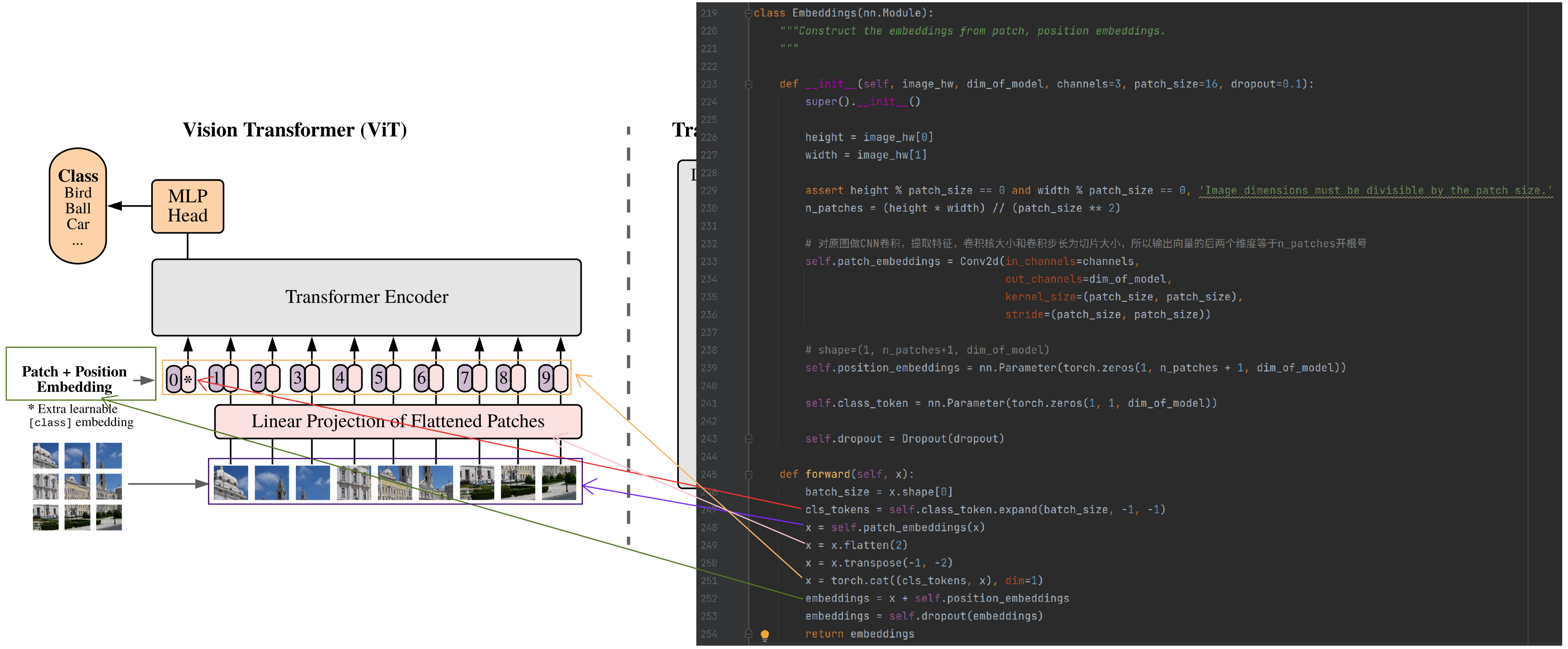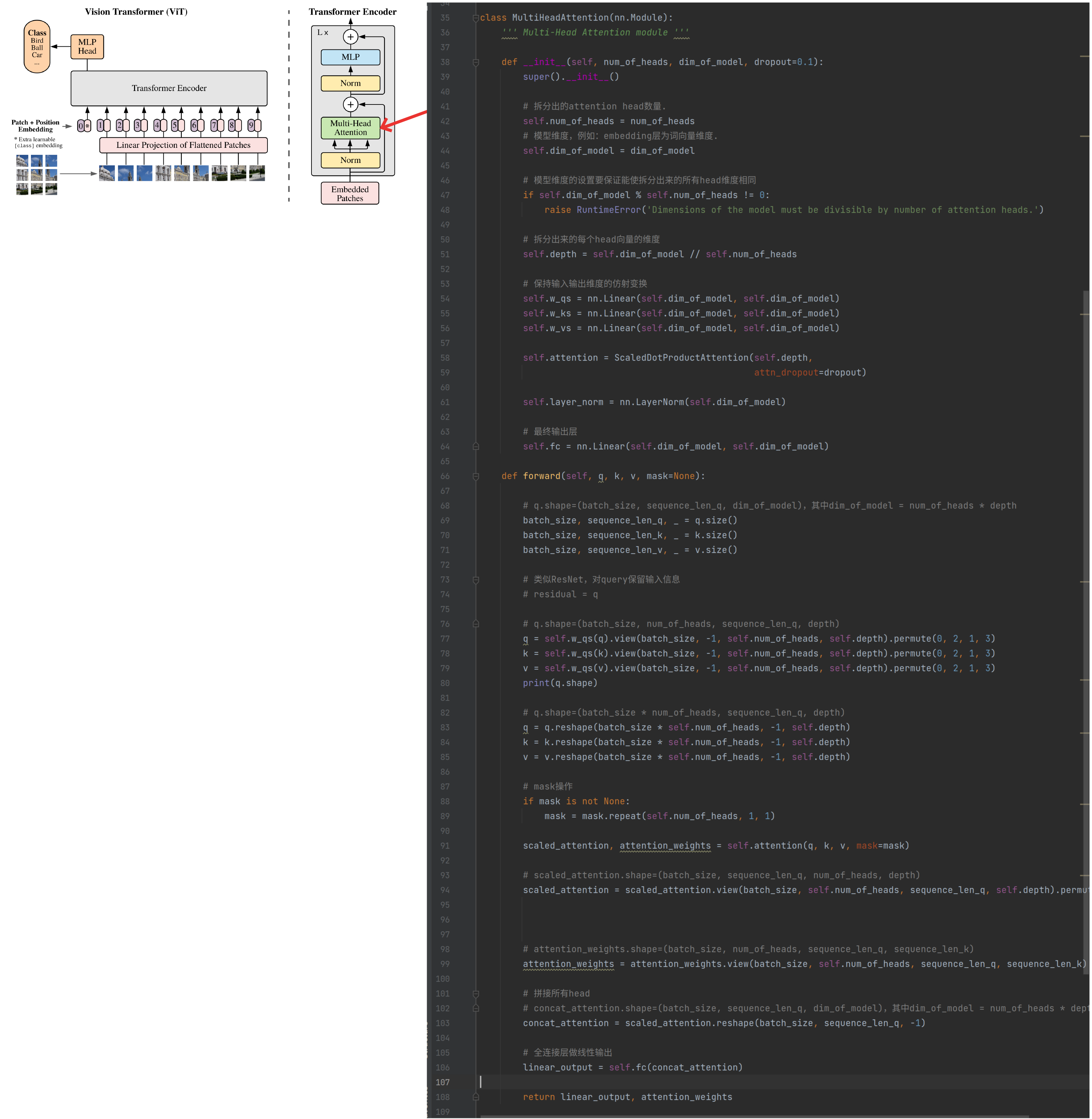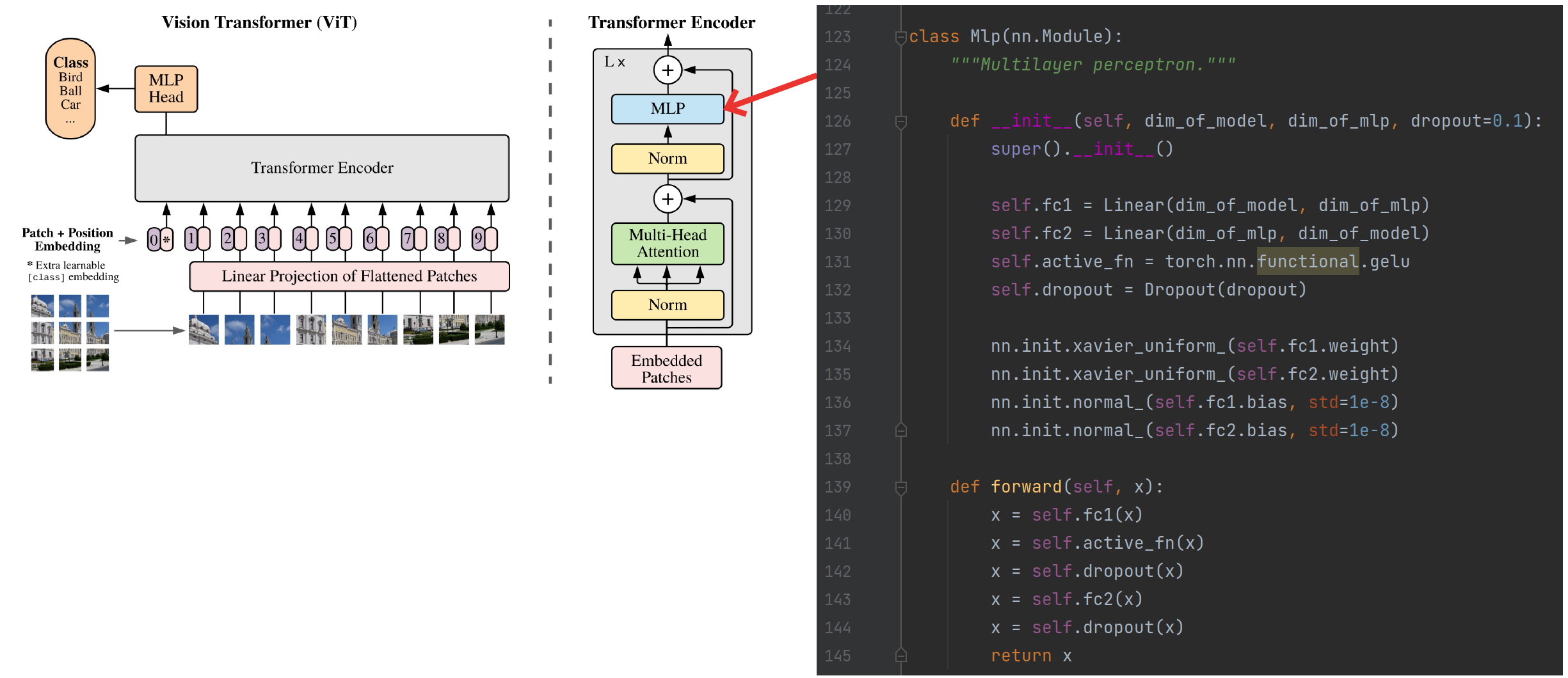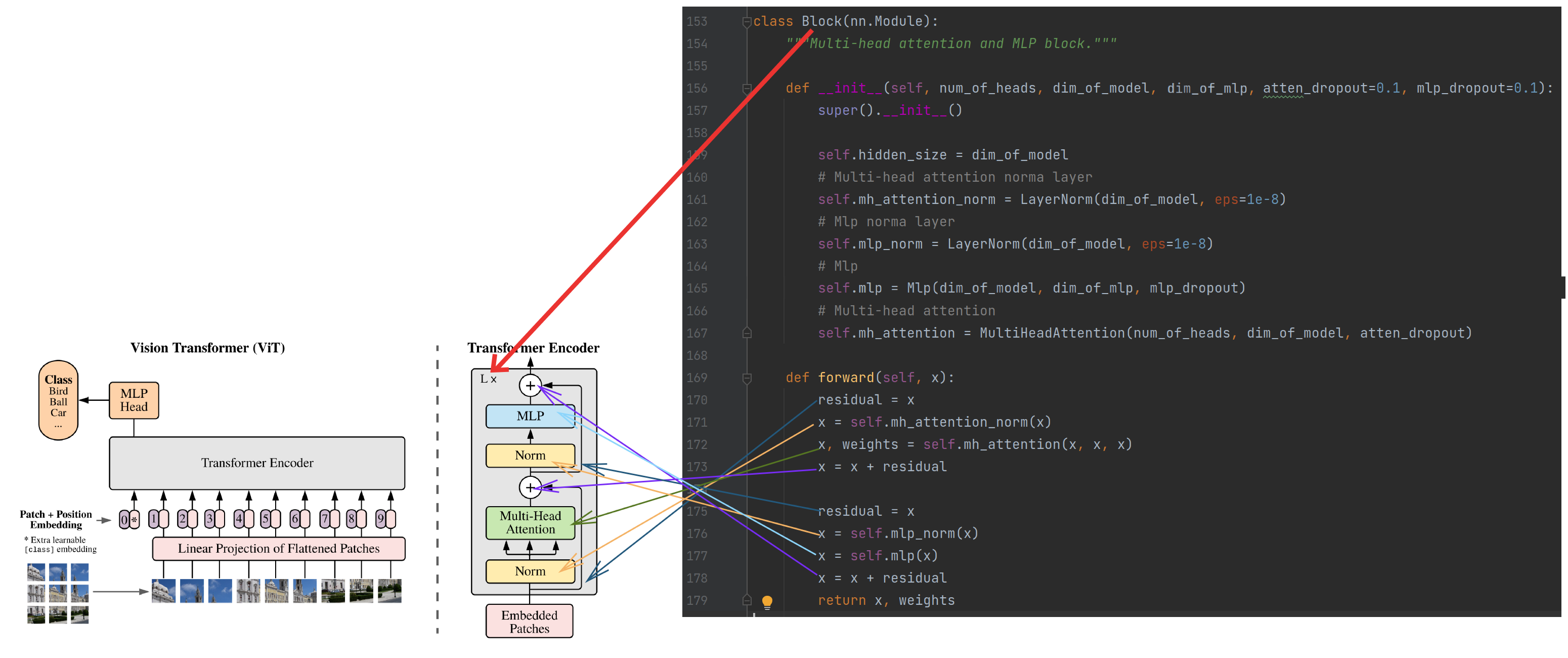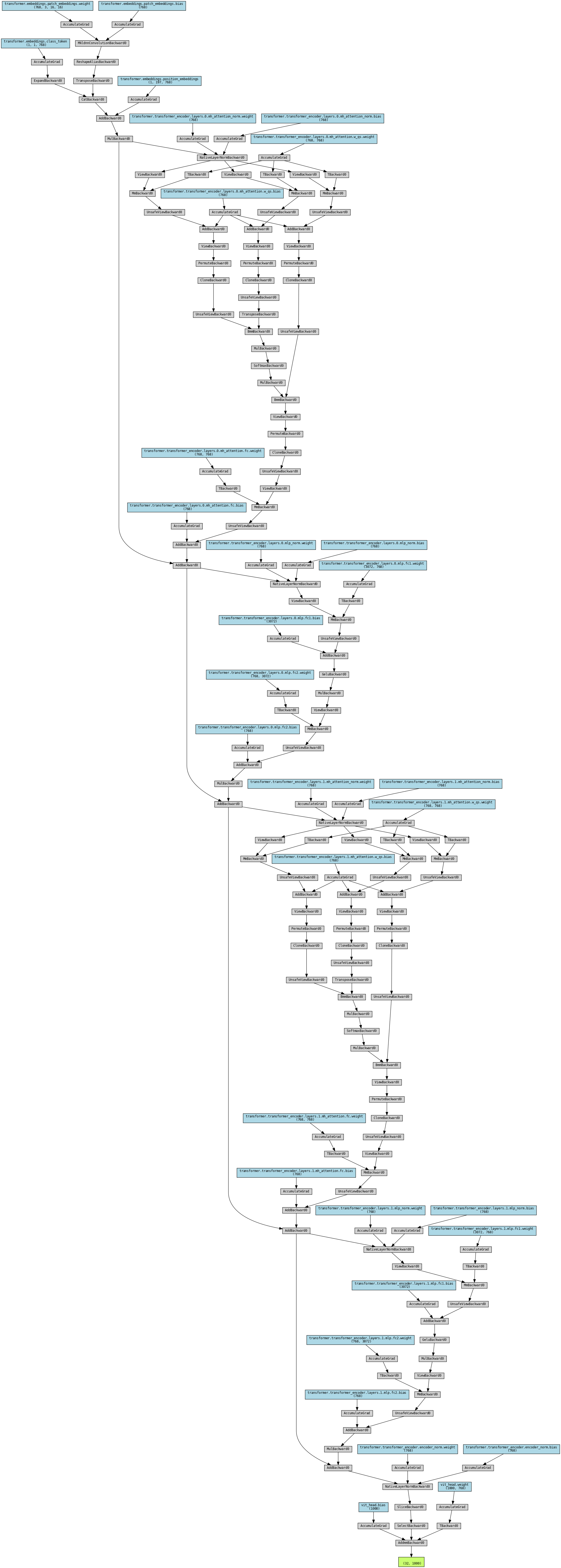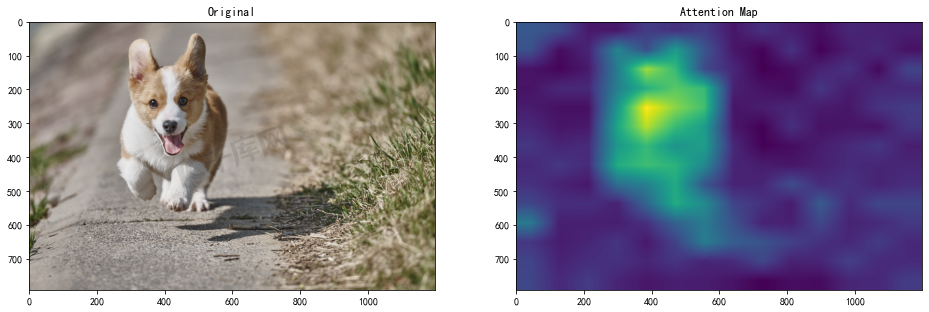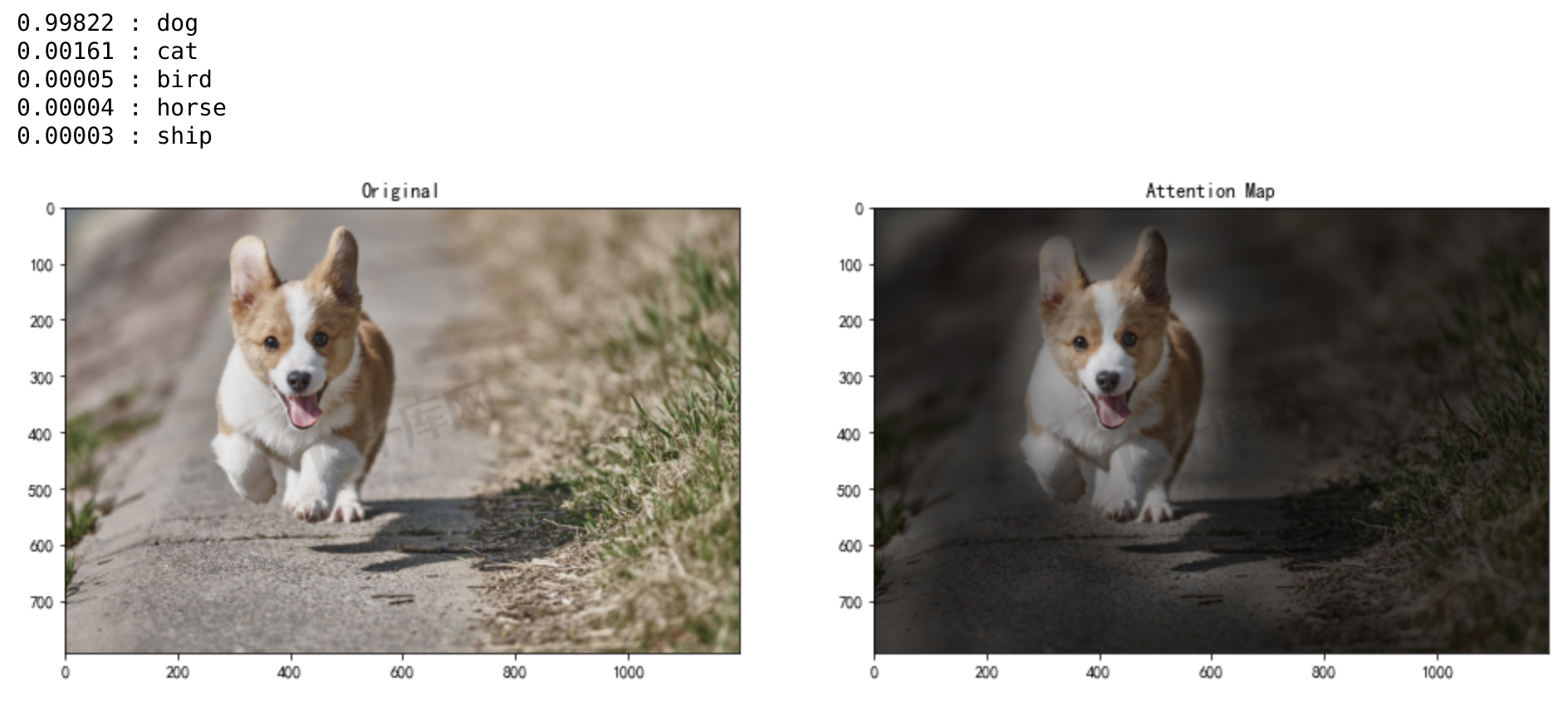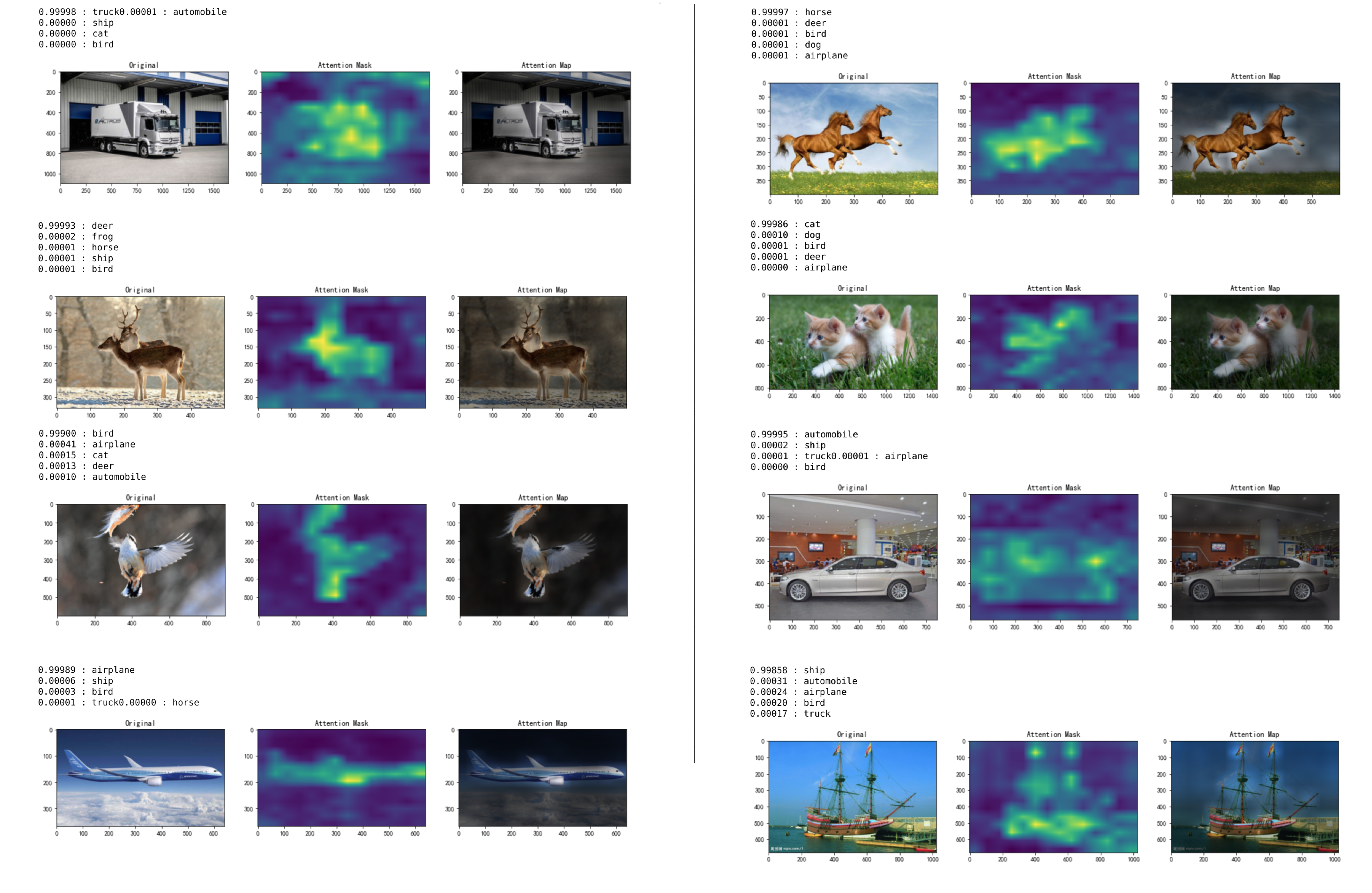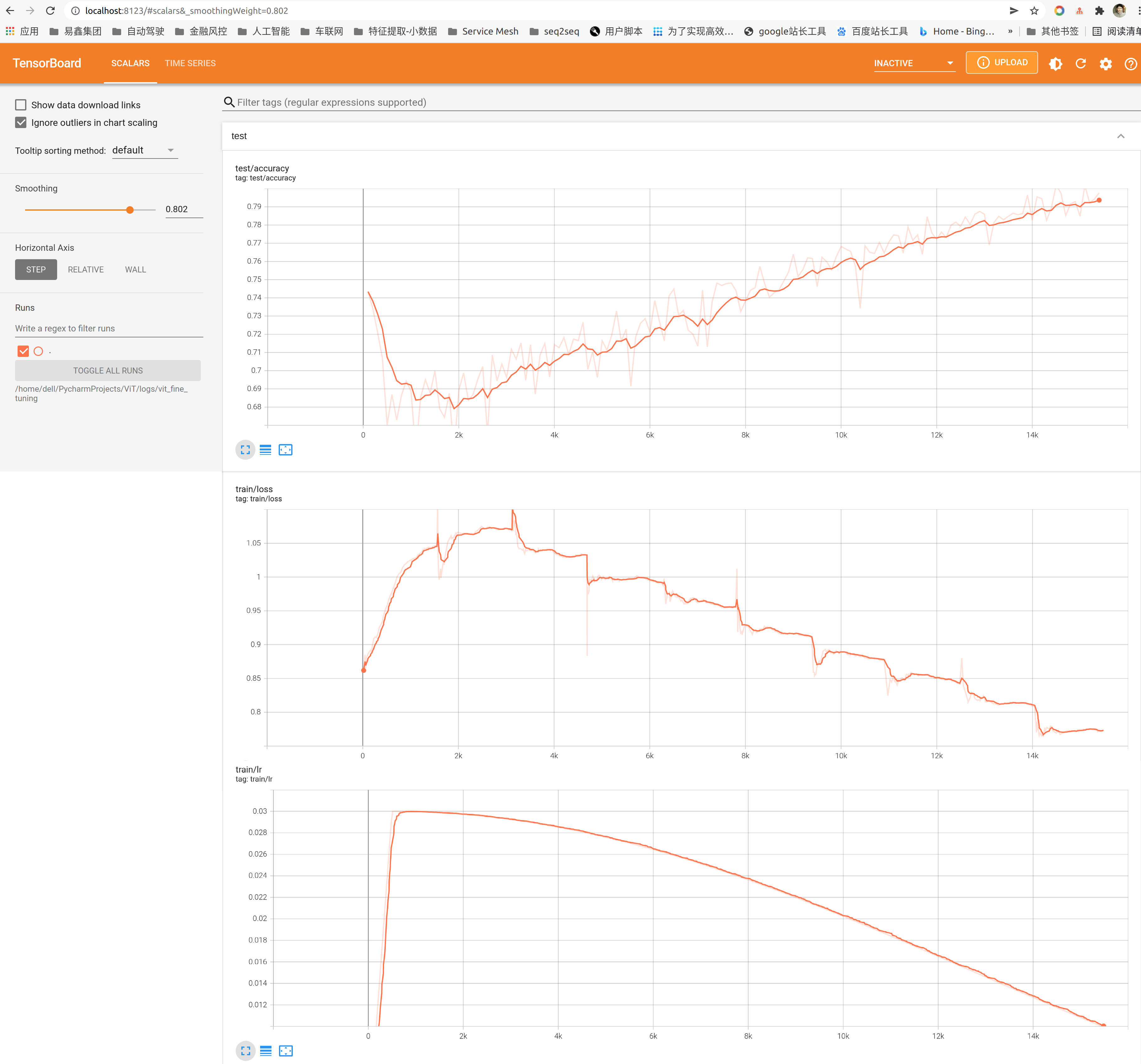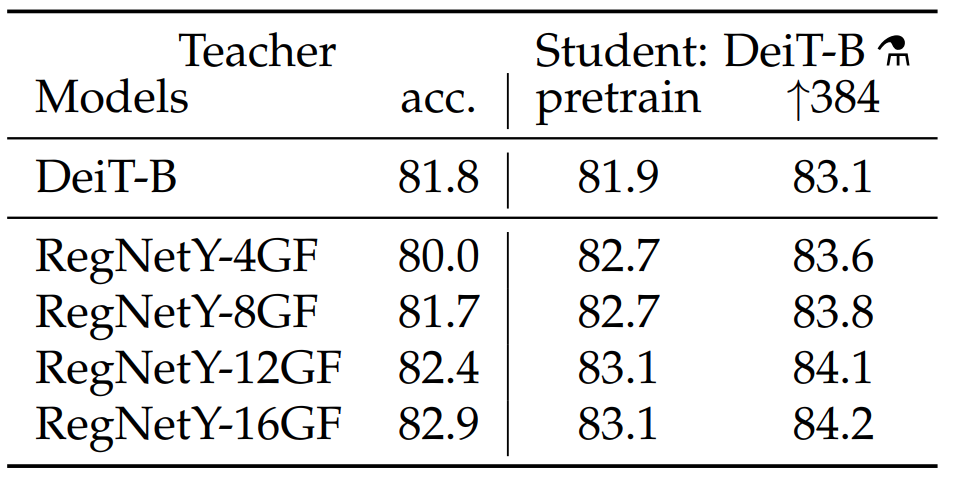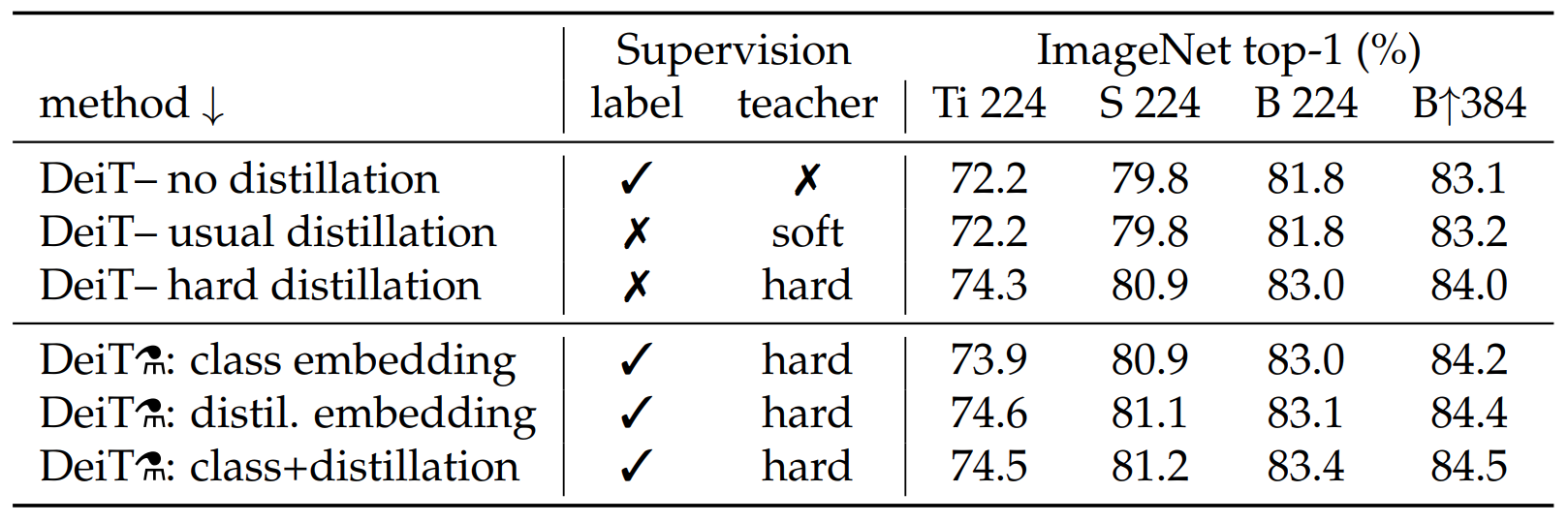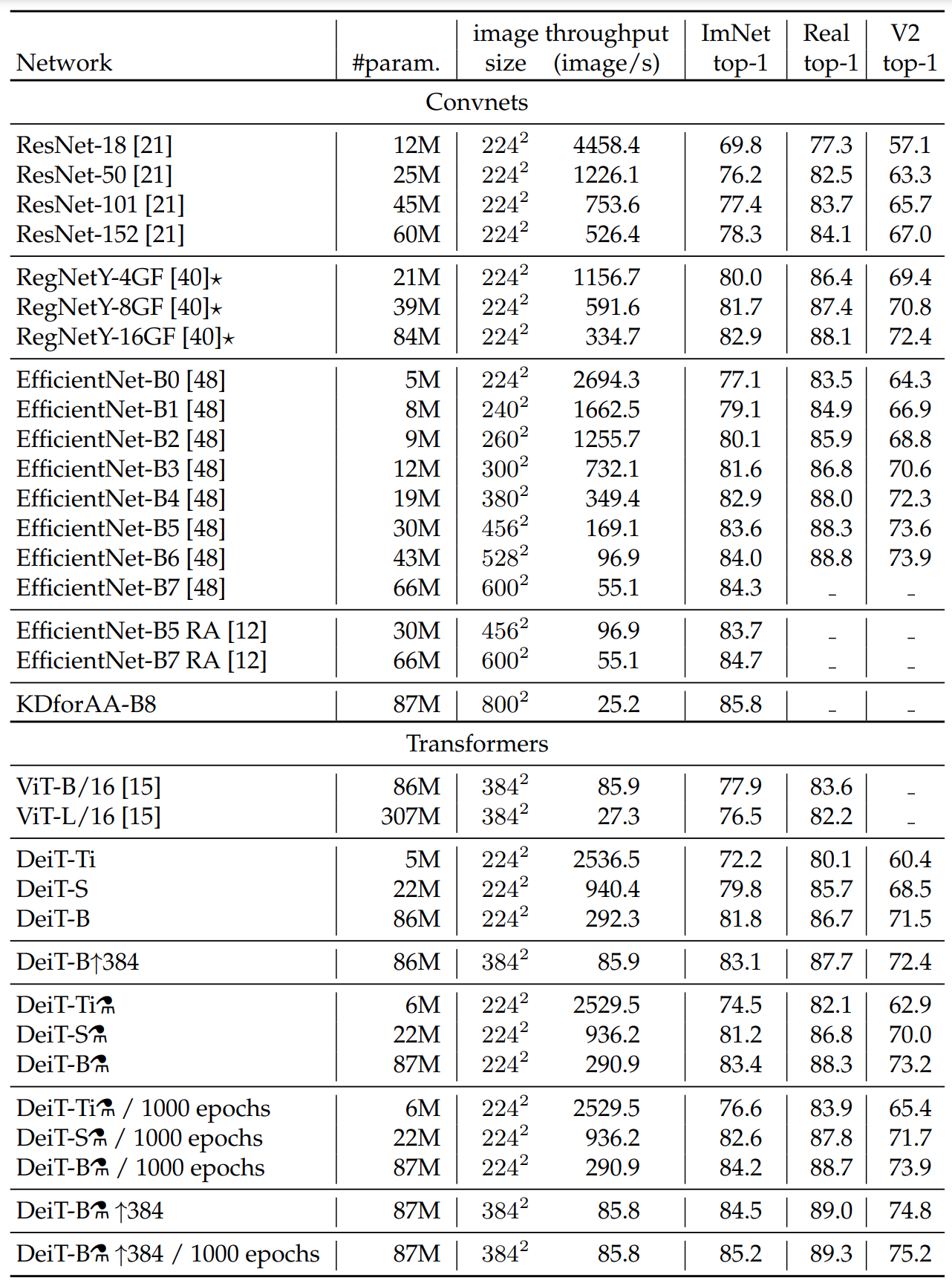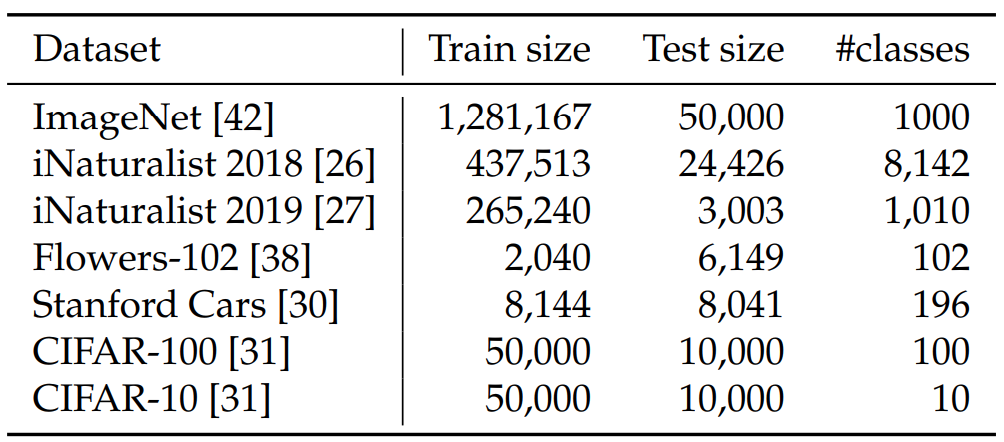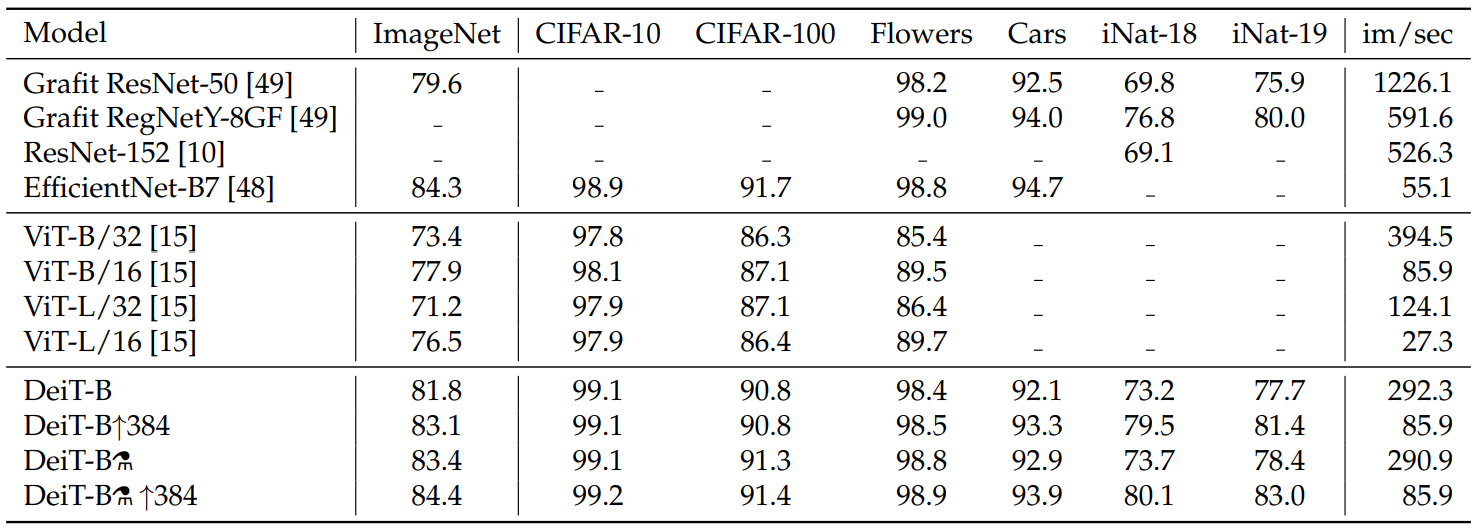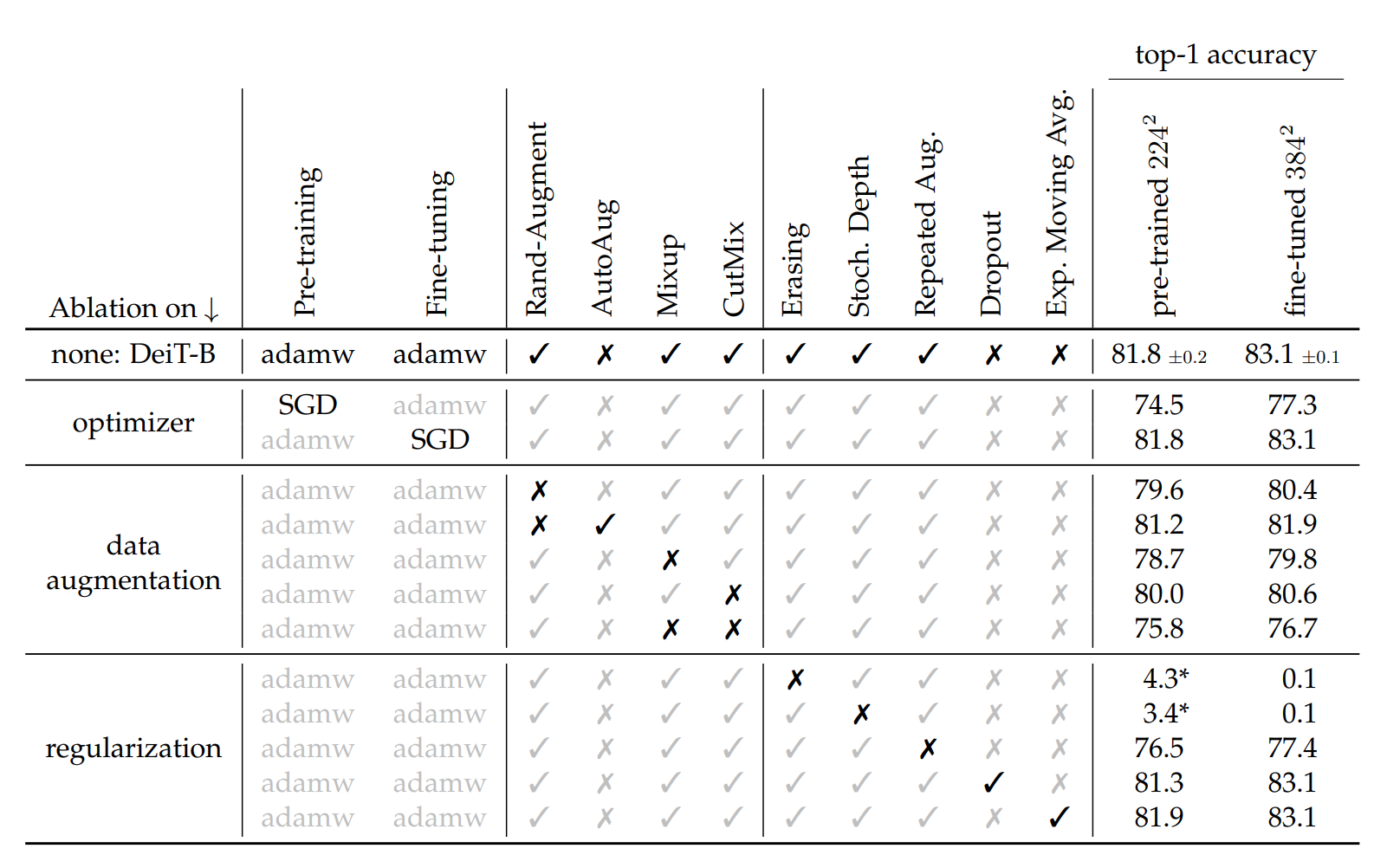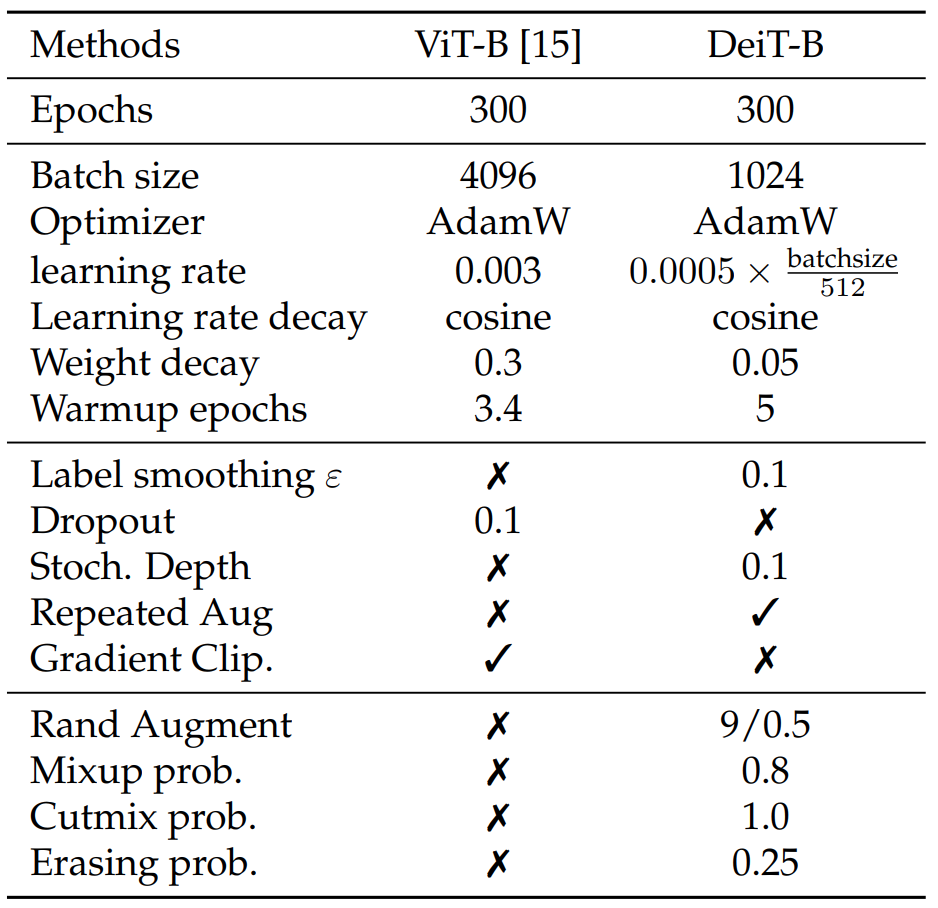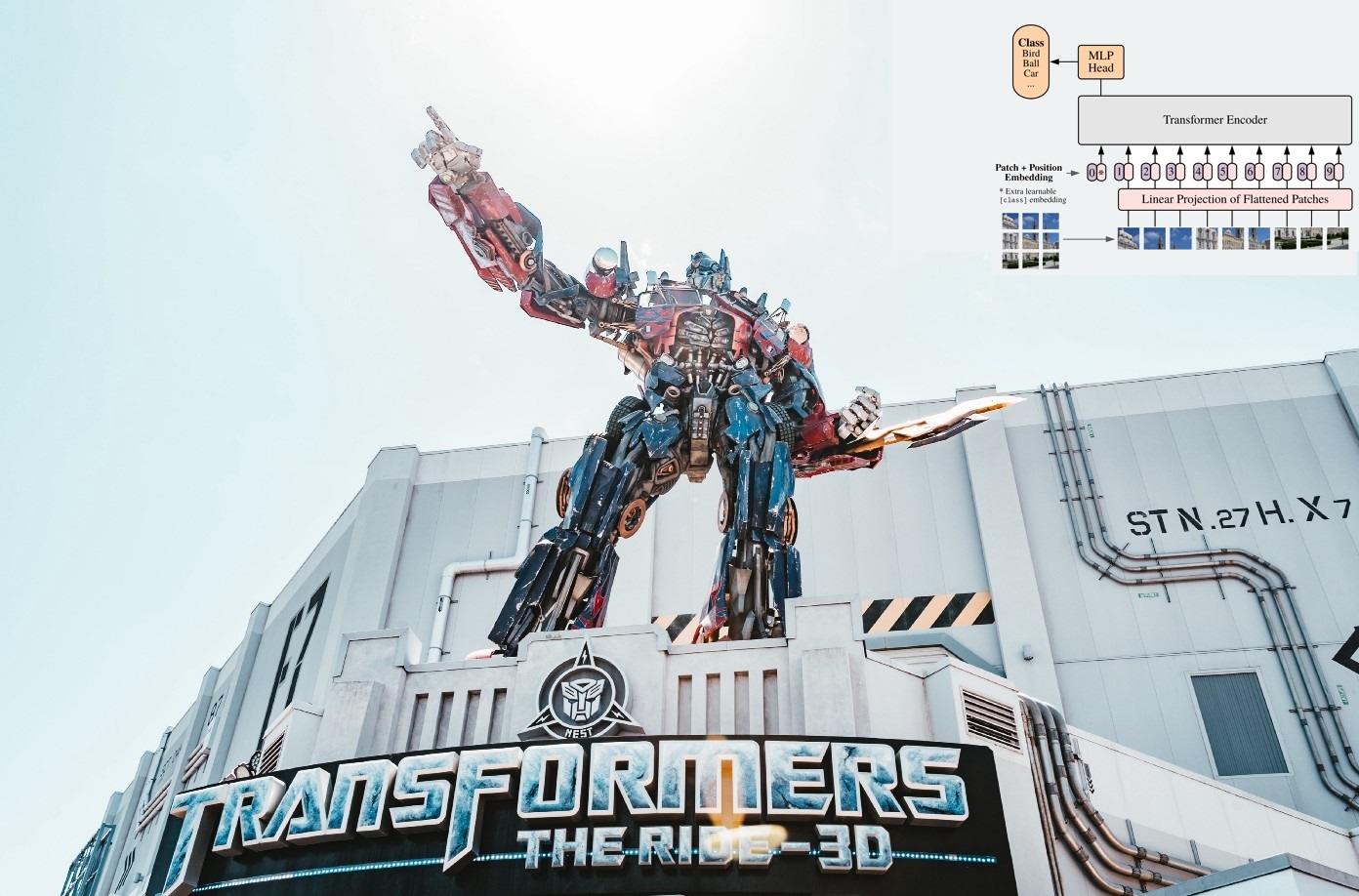 本章对Transformer在计算机视觉中的算法和应用做了原理介绍和效果展示。
本章对Transformer在计算机视觉中的算法和应用做了原理介绍和效果展示。
10. Vision Transformers
10.1 初版Vit
1、整体概览
第一次将Transformer机制引入CV领域(准确的说是图像分类)的是Google Brain的Neil Houlsby, Alexey Dosovitskiy等人在ICLR 2021提交的《An Image is Worth 16*16 Words: Transformers for Image Recognition at Scale》一文,本节对这篇文章做个概要介绍。
ViT用于图像分类有以下优缺点,优点:完全不使用CNN结构,自然也就避免了CNN的缺点、在分类效果上甚至好于CNN类模型(如:ResNet);缺点:需要比较大的数据集生成预训练模型、在新任务上做fine-tuning时要特别小心、想效果好,模型要很大。
ViT整体结构我认为比较原汁原味的继承了NLP中的Transformer,所以原理没什么好重复讲的,更多的是在做实验。
通用的结构包括:
- 具有标准Multi-Head Self-Attention的Transformer encoder
- Channel方向做归一化的Layer norm
- 位置编码Position embeddings。
个性化的结构包括:
- 由于标准Transformer接收1维序列,所以需要把2维的图片通过等大小切片并横向拼接转化为1维序列,即: 假设原始图片大小为:\(H×W×C\),每个切片分辨率大小为\(P×P\),则一共会有\(N=HW/P^2\)个切片,输入序列patch embeddings维度为:\(N×(P^2\cdot C)\)。
- 类似BERT,通过embedding一个class token(下图中加*的部分),来“概括”整幅图的语义表示,从而用于下游分类任务。
- Transformer encoder后面接一个多层感知机层(MLP layer)。

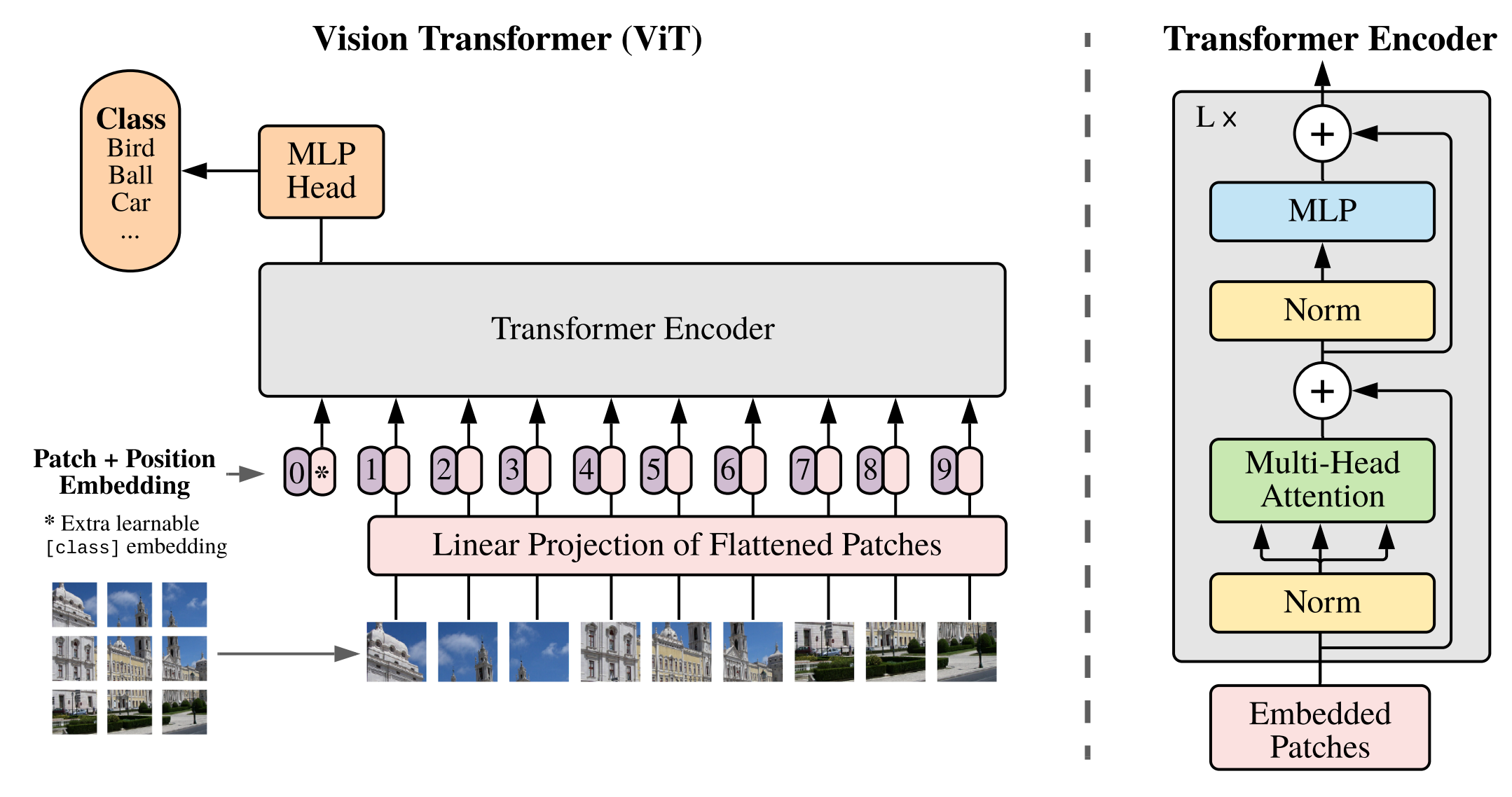
2、代码实践
Embedding
整个过程分几步:切片、引入class token、切片铺平、与位置编码相加,过程如下:
![]()
1、需要确保图片长×宽可以整除切片大小,例如,图片为224×224、切片大小为16×16,则满足要求
2、通过对原图做CNN卷积得到切片(patch),并把切片铺平
3、把class token向量拼接到切片铺平后的向量的最前面位置
5、将第3步得到的向量与位置编码向量相加,用dropout做下正则化后返回
MultiHeadAttention
稍作修改,把Normlayer去掉,沿用之前在第六章介绍的MultiHeadAttention结构,如下图:
![]()
MLP
使用BERT中的GELU激活函数,并构建一个两层感知机,如下图:
![]()
Block
组合Normlayer、MultiHeadAttention和MLP,得到一个基础的、可复制多个的最小Block结构,如下图:
![]()
Encoder
若干个Block组成一个Encoder,如下图:
![]()
TransformerEncoder
Embedding和Encoder共同组合成Transformer Encoder结构,如下图:
![]()
VisionTransformer
构建一个用于多分类的vision transformer,如下图:
![]()
以上过程的完整代码如下:
1
2
3
4
5
6
7
8
9
10
11
12
13
14
15
16
17
18
19
20
21
22
23
24
25
26
27
28
29
30
31
32
33
34
35
36
37
38
39
40
41
42
43
44
45
46
47
48
49
50
51
52
53
54
55
56
57
58
59
60
61
62
63
64
65
66
67
68
69
70
71
72
73
74
75
76
77
78
79
80
81
82
83
84
85
86
87
88
89
90
91
92
93
94
95
96
97
98
99
100
101
102
103
104
105
106
107
108
109
110
111
112
113
114
115
116
117
118
119
120
121
122
123
124
125
126
127
128
129
130
131
132
133
134
135
136
137
138
139
140
141
142
143
144
145
146
147
148
149
150
151
152
153
154
155
156
157
158
159
160
161
162
163
164
165
166
167
168
169
170
171
172
173
174
175
176
177
178
179
180
181
182
183
184
185
186
187
188
189
190
191
192
193
194
195
196
197
198
199
200
201
202
203
204
205
206
207
208
209
210
211
212
213
214
215
216
217
218
219
220
221
222
223
224
225
226
227
228
229
230
231
232
233
234
235
236
237
238
239
240
241
242
243
244
245
246
247
248
249
250
251
252
253
254
255
256
257
258
259
260
261
262
263
264
265
266
267
268
269
270
271
272
273
274
275
276
277
278
279
280
281
282
283
284
285
286
287
288
289
290
291
292
293
294
295
296
297
298
299
300
301
302
303
304
305
306
307
308
309
310
311
312
313
314
315
316
317
318import numpy as np
import torch
import torch.nn as nn
from torch.nn import Dropout, Linear, Conv2d, LayerNorm
import copy
class ScaledDotProductAttention(nn.Module):
''' Scaled Dot-Product Attention '''
def __init__(self, d_k, attn_dropout=0.1):
super().__init__()
# 缩放因子
self.scalar = 1 / np.power(d_k, 0.5)
self.dropout = nn.Dropout(attn_dropout)
self.softmax = nn.Softmax(dim=2)
def forward(self, q, k, v, mask=None):
# 计算q∙k
attn = torch.bmm(q, k.transpose(1, 2))
# 计算q∙k/sqr(d_k)
attn = attn * self.scalar
# attention masked
if mask is not None:
attn = attn.masked_fill(mask.bool(), -np.inf)
# 计算softmax(q∙k/sqr(d_k))
attn = self.softmax(attn)
attn = self.dropout(attn)
# 计算softmax(q∙k/sqr(d_k))∙v
sdp_output = torch.bmm(attn, v)
return sdp_output, attn
class MultiHeadAttention(nn.Module):
""" Multi-Head Attention module """
def __init__(self, num_of_heads, dim_of_model, dropout=0.1):
super().__init__()
# 拆分出的attention head数量.
self.num_of_heads = num_of_heads
# 模型维度,例如:embedding层为词向量维度.
self.dim_of_model = dim_of_model
# 模型维度的设置要保证能使拆分出来的所有head维度相同
if self.dim_of_model % self.num_of_heads != 0:
raise RuntimeError('Dimensions of the model must be divisible by number of attention heads.')
# 拆分出来的每个head向量的维度
self.depth = self.dim_of_model // self.num_of_heads
# 保持输入输出维度的仿射变换
self.w_qs = nn.Linear(self.dim_of_model, self.dim_of_model)
self.w_ks = nn.Linear(self.dim_of_model, self.dim_of_model)
self.w_vs = nn.Linear(self.dim_of_model, self.dim_of_model)
self.attention = ScaledDotProductAttention(self.depth,
attn_dropout=dropout)
self.layer_norm = nn.LayerNorm(self.dim_of_model)
# 最终输出层
self.fc = nn.Linear(self.dim_of_model, self.dim_of_model)
def forward(self, q, k, v, mask=None):
# q.shape=(batch_size, sequence_len_q, dim_of_model),其中dim_of_model = num_of_heads * depth
batch_size, sequence_len_q, _ = q.size()
batch_size, sequence_len_k, _ = k.size()
batch_size, sequence_len_v, _ = v.size()
# 类似ResNet,对query保留输入信息
# residual = q
# q.shape=(batch_size, num_of_heads, sequence_len_q, depth)
q = self.w_qs(q).view(batch_size, -1, self.num_of_heads, self.depth).permute(0, 2, 1, 3)
k = self.w_qs(k).view(batch_size, -1, self.num_of_heads, self.depth).permute(0, 2, 1, 3)
v = self.w_qs(v).view(batch_size, -1, self.num_of_heads, self.depth).permute(0, 2, 1, 3)
print(q.shape)
# q.shape=(batch_size * num_of_heads, sequence_len_q, depth)
q = q.reshape(batch_size * self.num_of_heads, -1, self.depth)
k = k.reshape(batch_size * self.num_of_heads, -1, self.depth)
v = v.reshape(batch_size * self.num_of_heads, -1, self.depth)
# mask操作
if mask is not None:
mask = mask.repeat(self.num_of_heads, 1, 1)
scaled_attention, attention_weights = self.attention(q, k, v, mask=mask)
# scaled_attention.shape=(batch_size, sequence_len_q, num_of_heads, depth)
scaled_attention = scaled_attention.view(batch_size, self.num_of_heads, sequence_len_q, self.depth).permute(0,
2,
1,
3)
# attention_weights.shape=(batch_size, num_of_heads, sequence_len_q, sequence_len_k)
attention_weights = attention_weights.view(batch_size, self.num_of_heads, sequence_len_q, sequence_len_k)
# 拼接所有head
# concat_attention.shape=(batch_size, sequence_len_q, dim_of_model),其中dim_of_model = num_of_heads * depth
concat_attention = scaled_attention.reshape(batch_size, sequence_len_q, -1)
# 全连接层做线性输出
linear_output = self.fc(concat_attention)
return linear_output, attention_weights
# (num_of_heads, dim_of_model)
mha = MultiHeadAttention(12, 768)
# (batch_size, sequence_len_q, dim_of_model)
q = torch.Tensor(32, 197, 768)
output, attention_weights = mha(q, k=q, v=q, mask=None)
print('shape of output:"{0}", shape of attention weight:"{1}"'.format(output.shape, attention_weights.shape))
class Mlp(nn.Module):
"""Multilayer perceptron."""
def __init__(self, dim_of_model, dim_of_mlp, dropout=0.1):
super().__init__()
self.fc1 = Linear(dim_of_model, dim_of_mlp)
self.fc2 = Linear(dim_of_mlp, dim_of_model)
self.active_fn = torch.nn.functional.gelu
self.dropout = Dropout(dropout)
nn.init.xavier_uniform_(self.fc1.weight)
nn.init.xavier_uniform_(self.fc2.weight)
nn.init.normal_(self.fc1.bias, std=1e-8)
nn.init.normal_(self.fc2.bias, std=1e-8)
def forward(self, x):
x = self.fc1(x)
x = self.active_fn(x)
x = self.dropout(x)
x = self.fc2(x)
x = self.dropout(x)
return x
mp = Mlp(768, 3072)
r = mp(output)
print('shape of mlp:"{0}""'.format(r.shape))
class Block(nn.Module):
"""Multi-head attention and MLP block."""
def __init__(self, num_of_heads, dim_of_model, dim_of_mlp, atten_dropout=0.1, mlp_dropout=0.1):
super().__init__()
self.hidden_size = dim_of_model
# Multi-head attention norma layer
self.mh_attention_norm = LayerNorm(dim_of_model, eps=1e-8)
# Mlp norma layer
self.mlp_norm = LayerNorm(dim_of_model, eps=1e-8)
# Mlp
self.mlp = Mlp(dim_of_model, dim_of_mlp, mlp_dropout)
# Multi-head attention
self.mh_attention = MultiHeadAttention(num_of_heads, dim_of_model, atten_dropout)
def forward(self, x):
residual = x
x = self.mh_attention_norm(x)
x, weights = self.mh_attention(x, x, x)
x = x + residual
residual = x
x = self.mlp_norm(x)
x = self.mlp(x)
x = x + residual
return x, weights
b = Block(12, 768, 3072)
q = torch.Tensor(32, 197, 768)
output, attention_weights = b(q)
print('shape of output:"{0}", shape of attention weight:"{1}"'.format(output.shape, attention_weights.shape))
class Encoder(nn.Module):
"""Encoder with n blocks."""
def __init__(self, num_of_heads, dim_of_model, dim_of_mlp, num_layers, atten_dropout=0.1, mlp_dropout=0.1):
super().__init__()
self.layers = nn.ModuleList()
self.encoder_norm = LayerNorm(dim_of_model, eps=1e-8)
for _ in range(num_layers):
layer = Block(num_of_heads, dim_of_model, dim_of_mlp, atten_dropout, mlp_dropout)
self.layers.append(copy.deepcopy(layer))
def forward(self, x):
attn_weights_list = []
for layer_block in self.layers:
x, weights = layer_block(x)
attn_weights_list.append(weights)
encoded = self.encoder_norm(x)
return encoded, attn_weights_list
encoder = Encoder(12, 768, 3072, 1)
q = torch.Tensor(32, 197, 768)
output, attention_weights = encoder(q)
print('shape of output:"{0}", shape of attention weight:"{1}"'.format(output.shape, attention_weights[0].shape))
class Embeddings(nn.Module):
"""Construct the embeddings from patch, position embeddings.
"""
def __init__(self, image_hw, dim_of_model, channels=3, patch_size=16, dropout=0.1):
super().__init__()
height = image_hw[0]
width = image_hw[1]
assert height % patch_size == 0 and width % patch_size == 0, 'Image dimensions must be divisible by the patch size.'
n_patches = (height * width) // (patch_size ** 2)
# 对原图做CNN卷积,提取特征,卷积核大小和卷积步长为切片大小,所以输出向量的后两个维度等于n_patches开根号
self.patch_embeddings = Conv2d(in_channels=channels,
out_channels=dim_of_model,
kernel_size=(patch_size, patch_size),
stride=(patch_size, patch_size))
# shape=(1, n_patches+1, dim_of_model)
self.position_embeddings = nn.Parameter(torch.zeros(1, n_patches + 1, dim_of_model))
self.class_token = nn.Parameter(torch.zeros(1, 1, dim_of_model))
self.dropout = Dropout(dropout)
def forward(self, x):
batch_size = x.shape[0]
cls_tokens = self.class_token.expand(batch_size, -1, -1)
x = self.patch_embeddings(x)
x = x.flatten(2)
x = x.transpose(-1, -2)
x = torch.cat((cls_tokens, x), dim=1)
embeddings = x + self.position_embeddings
embeddings = self.dropout(embeddings)
return embeddings
emb = Embeddings((224, 224), 768)
q = torch.Tensor(32, 3, 224, 224)
r = emb(q)
print('shape of embedding:"{0}""'.format(r.shape))
class TransformerEncoder(nn.Module):
"""Embedding layer and Encoder Layer."""
def __init__(self, num_of_heads, dim_of_model, dim_of_mlp, num_layers,
image_hw, channels=3, patch_size=16,
em_dropout=0.1, atten_dropout=0.1, mlp_dropout=0.1):
super().__init__()
self.embeddings = Embeddings(image_hw, dim_of_model, channels, patch_size, em_dropout)
self.transformer_encoder = Encoder(num_of_heads, dim_of_model, dim_of_mlp, num_layers, atten_dropout,
mlp_dropout)
def forward(self, x):
embedded = self.embeddings(x)
encoded, attention_weights = self.transformer_encoder(embedded)
return encoded, attention_weights
trans = TransformerEncoder(12, 768, 3072, 2, (224, 224))
q = torch.Tensor(32, 3, 224, 224)
r, _ = trans(q)
print('shape of transformer encoder:"{0}""'.format(r.shape))
class VisionTransformer(nn.Module):
"""Vit."""
def __init__(self, num_of_heads, dim_of_model, dim_of_mlp, num_layers,
image_hw=(224, 224), channels=3, patch_size=16,
em_dropout=0.1, atten_dropout=0.1, mlp_dropout=0.1, num_classes=1000):
super().__init__()
self.num_classes = num_classes
self.transformer = TransformerEncoder(num_of_heads, dim_of_model, dim_of_mlp, num_layers,
image_hw, channels, patch_size,
em_dropout, atten_dropout, mlp_dropout)
self.vit_head = Linear(dim_of_model, num_classes)
def forward(self, x):
encoded, attention_weights = self.transformer(x)
return self.vit_head(encoded[:, 0]), attention_weights
vit = VisionTransformer(12, 768, 3072, 2, (224, 224))
q = torch.Tensor(32, 3, 224, 224)
r, _ = vit(q)
print('shape of vision transformer:"{0}""'.format(r.shape))
from torchviz import make_dot
architecture = make_dot(r, params=dict(list(vit.named_parameters())))
architecture.format = "png"
architecture.directory = "data"
architecture.view()假设,采用12个head,模型隐层维度为768,感知机维度为3072,block个数为2,图片大小为224×224,batch大小为32,则网络结构可视化后如下:
![]()
直观看个transformer机制在图像中的作用更有感觉:随着attention机制作用的层数越深,对柯基的注意力越来越集中,分类的准确率非常高:
对每个block的header求平均attention值,类似这样:
取出最后一个block的attention分布图,如下:1
2
3
4
5
6
7
8
9
10
11
12
13
14
15
16
17
18
19
20
21
22
23
24import torch
from torchvision import transforms
from PIL import Image
resolution = (224, 224)
num_of_heads = 12
dim_of_model = 768
dim_of_mlp = 3072
num_layers = 2
transform = transforms.Compose([
transforms.Resize(resolution),
transforms.ToTensor()])
im = Image.open("attention_data/ship.jpeg").convert('RGB')
x = transform(im)
vit = VisionTransformer(num_of_heads, dim_of_model, dim_of_mlp, num_layers, resolution)
q = x.reshape(1, 3, 224, 224)
# attention_matrix is a list.
result, attention_matrix = vit(q)
# attention_matrix size: (num_layers, attention map resolution, attention map resolution)=(2, 197, 197)
attention_matrix = torch.mean(torch.stack(attention_matrix).squeeze(1), dim=1)![]()
逐层展示attention分布图(同样是每层所有header的attention值求平均),如下:
![]()
在cifar10数据集训练模型后,对柯基做分类的结果如下:
![]()
其他例子可视化:
![]()
模型训练 以cifar10分类问题为例,利用torchvision的datasets模块自动下载和组织训练与测试数据集,并利用transforms模块做样本处理,类似这样:
之后以batch方式训练和验证模型,如下:1
2
3
4
5
6
7
8
9
10
11
12
13
14
15
16
17
18transform_train = transforms.Compose([
transforms.RandomResizedCrop(img_size, scale=(0.05, 1.0)),
transforms.ToTensor(),
transforms.Normalize(mean=[0.5, 0.5, 0.5], std=[0.5, 0.5, 0.5]),
])
transform_test = transforms.Compose([
transforms.Resize(img_size),
transforms.ToTensor(),
transforms.Normalize(mean=[0.5, 0.5, 0.5], std=[0.5, 0.5, 0.5]),
])
trainset = datasets.CIFAR10(root="./data",
train=True,
download=True,
transform=transform_train)
testset = datasets.CIFAR10(root="./data",
train=False,
download=True,
transform=transform_test)1
2
3
4
5
6
7
8
9
10
11
12
13
14
15
16
17
18
19
20
21
22
23
24
25
26
27
28
29
30
31
32
33
34
35
36
37
38
39
40
41
42
43
44
45
46
47
48
49
50
51
52
53
54
55
56
57
58
59
60
61
62
63
64
65
66
67
68
69
70
71
72
73
74
75
76
77
78
79
80
81
82
83
84
85
86
87
88
89
90
91
92
93
94
95
96
97
98
99
100
101
102
103
104
105
106
107
108
109
110
111
112def train(self):
"""
training the model
:return: None
"""
self.load_model()
# 加载训练数据和测试数据
train_loader, test_loader = data_loader(self.config.items.img_size,
self.config.items.train_batch_size,
self.config.items.test_batch_size)
# 选择一个一阶最优化方法
if self.config.items.optimizer == 'adam':
optimizer = torch.optim.Adam(self.model.parameters(),
lr=self.config.items.learning_rate)
elif self.config.items.optimizer == 'adagrad':
optimizer = torch.optim.Adagrad(self.model.parameters(),
lr=self.config.items.learning_rate)
else:
optimizer = torch.optim.SGD(self.model.parameters(),
lr=self.config.items.learning_rate,
momentum=0.9)
# 总的迭代步数
t_total = self.config.items.num_steps
# 以此步数做学习率分段函数
warmup_steps = self.config.items.warmup_steps
# 随着迭代步数增加,调整学习率的策略(cosine法|S)
# *
# * *
# * *
# * *
# * *
# * *
# * *
# * *
# * * * *
scheduler = LambdaLR(optimizer=optimizer,
lr_lambda=lambda step: float(step) / warmup_steps if step < warmup_steps else 0.5 * (
math.cos(math.pi * 0.6 * 2.0 * (step - warmup_steps) / (
t_total - warmup_steps)) + 1.0))
print("\r\n***** Running training *****")
# 模型所有参数梯度值初始化为0
self.model.zero_grad()
# 计算平均损失
loss_sum = 0
loss_count = 0
# 当前迭代步数
current_step = 0
# 当前最佳精度
current_best_acc = 0
while True:
self.model.train()
# 初始化进度条
epoch_iterator = tqdm(train_loader,
desc="Training Progress [x / x Total Steps] {loss=x.x}",
bar_format="{l_bar}{r_bar}",
dynamic_ncols=True)
for step, batch in enumerate(epoch_iterator):
# 获取一个batch,并把数据发送到相应设备上(如:GPU卡)
batch = tuple(t.to(self.config.items.device) for t in batch)
# 特征与标注数据
features, label = batch
loss, _ = self.model(features, label)
# 自动反向传播求梯度
loss.backward()
# 全局平均损失
loss_sum += loss.item()
loss_count += 1
# 梯度正则化,缓解过拟合
torch.nn.utils.clip_grad_norm_(self.model.parameters(), 1)
# 执行一步最优化方法
optimizer.step()
# 执行学习率调整策略
scheduler.step()
# 梯度清零
optimizer.zero_grad()
# 存储当前迭代步数
current_step += 1
epoch_iterator.set_description(
"Training Progress [%d / %d Total Steps] {loss=%2.5f}" % (
current_step, t_total, loss_sum / loss_count)
)
self.writer.add_scalar("train/loss", scalar_value=loss_sum / loss_count, global_step=current_step)
self.writer.add_scalar("train/lr", scalar_value=scheduler.get_last_lr()[0], global_step=current_step)
# 每迭代若干步后做测试集验证
if current_step % self.config.items.test_epoch == 0:
accuracy = self.test(test_loader, current_step)
# 测试集上表现好的模型被存储,并更新当前最佳精度
if current_best_acc < accuracy:
self.save_model()
current_best_acc = accuracy
# 接着训练
self.model.train()
if current_step % t_total == 0:
break
loss_sum = 0
loss_count = 0
if current_step % t_total == 0:
break
self.writer.close()
print("Best Accuracy: \t%f" % current_best_acc)
print("***** End Training *****")需要注意,为了提升训练效果,学习率采用分段函数调整,训练前期猛一点,采用线性增长,过了一定阈值后逐步平缓,采用cosine下降。 另外将训练的过程数据写入日志,可以利用tensorboard可视化的查看训练过程,执行命令诸如:
可以在浏览器查看,如:1
tensorboard --logdir=*** --port 8123
![]()
以上是对最初transformer机制被应用于CV的简单介绍和代码实践,完整代码在这里。
3、小结
ViT有两个很关键的点:
采用self-attention机制捕获序列中元素的长依赖(long term dependencies);
利用在大规模数据集(如:ImageNet)上训练的模型作为预训练模型(pre-training)会有好的效果,反过来说,如果数据集不够大,预训练模型的泛化性会比较差。
实践证明得益于Transformer这种结构带来的优点,使得它有比较大的潜力,也成为了后续CV的重点研究领域,期待未来有更好的表现。
10.2 DeiT
初版ViT有一个很大的问题是:要想模型效果好,训练数据集要很大,不管是数据集获取难度还是训练速度都受限,FB在《Training data-efficient image transformers & distillation through attention》一文提出一种解决该问题的方法,
优点是:只是用ImageNet这样的公开数据集做训练,纯Transformer结构,对初版ViT只做了比较小的改动,由于使用蒸馏机制,使得训练速度大大提升,单机8卡训练了3天,DeiT-B 384在只使用88M参数量规模下达到了Top 1 Accuracy 85.2% 的效果,Image Classification on ImageNet 榜单排名84(截止2022.1.6)。
缺点是:需要一个预训练好的CNN模型当teacher,所以显然最终效果受teacher影响极大。
1、模型结构 相比初版ViT,它主要在Embedding层增加了一个类似class token的distillation token,前者表征了对真实标签的全局隐语义概括,后者表征了对teacher模型的预测标签的全局隐语义概括。具体结构如下: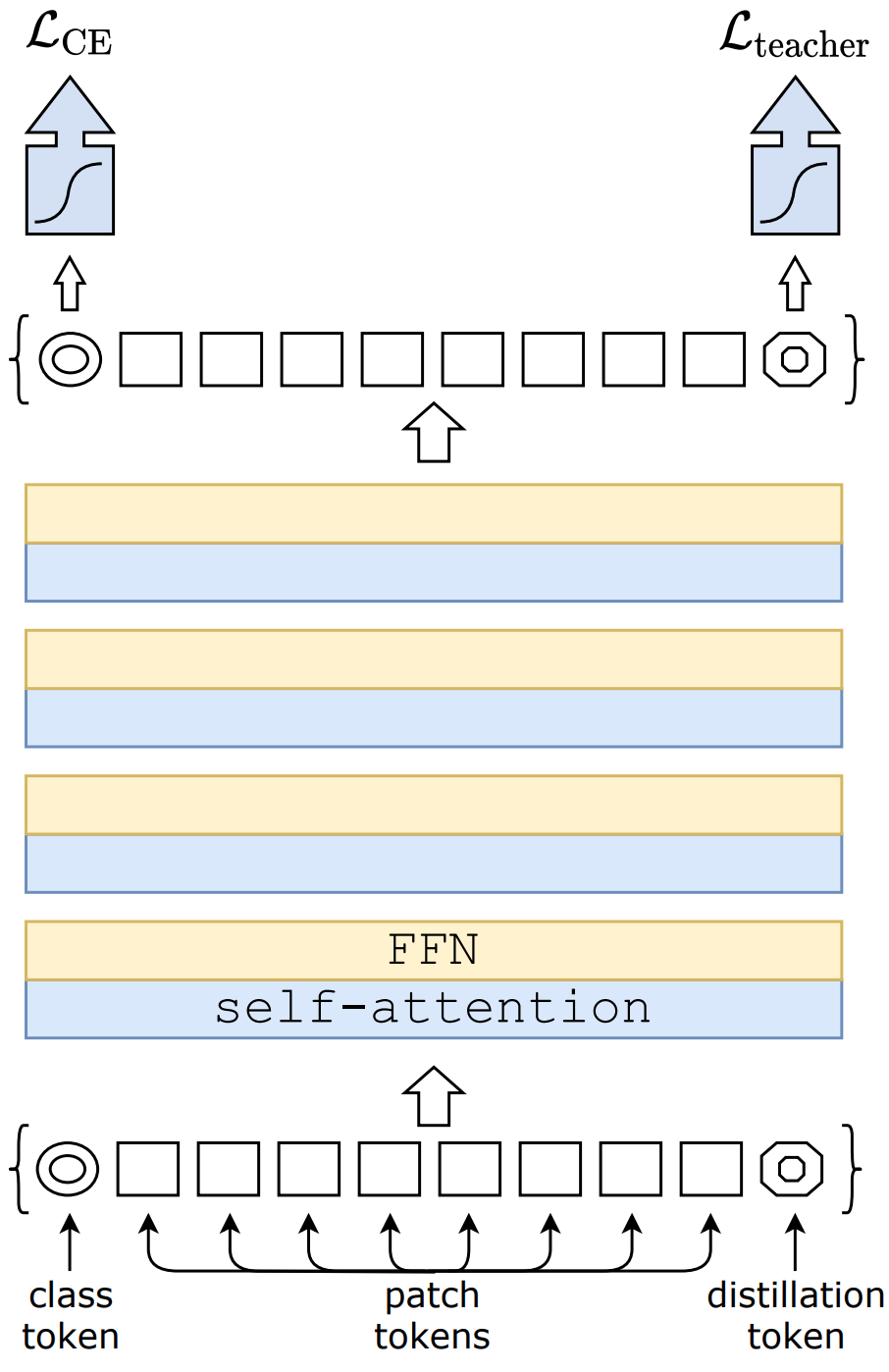
损失函数方面,初版ViT采用预测值与真实标签的交叉熵损失,DeiT除此之外增加了蒸馏损失,即预测值与teacher模型的预测标签的交叉熵损失,细节如下:
软蒸馏(Soft Distillation) \[ \mathcal{L}_{global}=(1-\lambda)\mathcal{L}_{CE}(\psi(Z_s),y)+\lambda \tau ^2KL(\psi(Z_s/\tau),\psi(Z_t/\tau)) \] 其中,\(y\)为真实标签,\(\psi\)为softmax函数,\(\tau\)为蒸馏参数,\(\lambda\) 是用来平衡交叉熵损失和e Kullback–Leibler divergence 损失的,\(\mathcal{L}_{CE}\)为交叉熵损失。
硬蒸馏(Hard-label Distillation) \[ \mathcal{L}_{global}^{hardDistill}=\frac{1}{2}\mathcal{L}_{CE}(\psi(Z_s),y)+\frac{1}{2}\mathcal{L}_{CE}(\psi(Z_s),y_t) \] 其中,$ y_t = argmax_cZ_t(c) $是把teacher的预测标签当做真实标签。 一个有趣的现象是:class token和distillation token会朝不同方向收敛,且随着迭代次数和层数,这两个向量的cosine相似度会越来越接近(但不会相等)。
2、实验结论
不同的DeiT结构及效果如下:
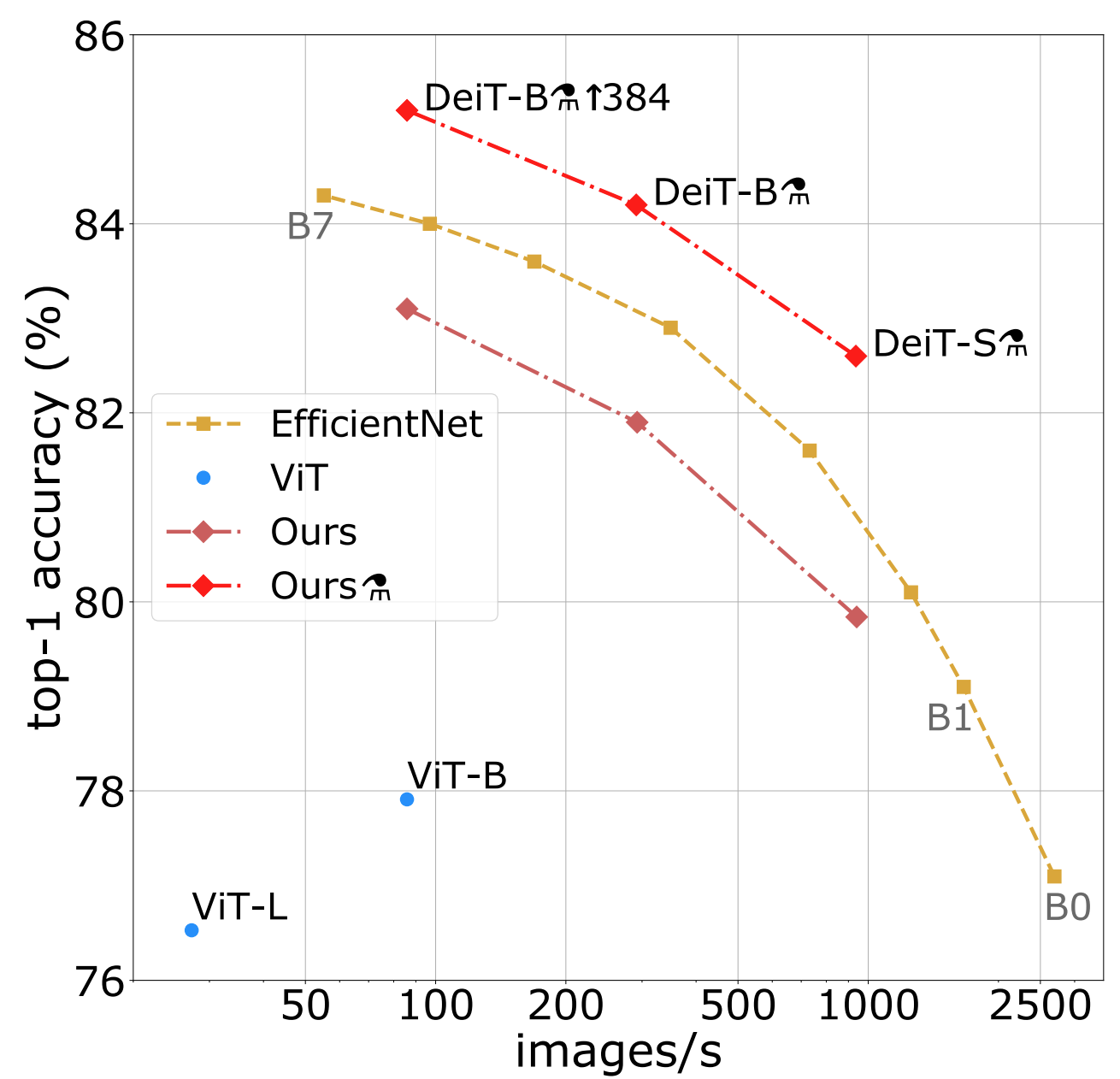
CNN类模型作为teacher比transformer类模型效果更好,原因可能是transformer通过蒸馏继承了归纳偏置导致,具体解释可以看这篇论文。
![]()
上图中:384代表fine-tuning得到的模型使用了分辨率为384×384图像做训练,⚗代表蒸馏后得到的模型。
硬蒸馏效果好于软蒸馏和不蒸馏,同时使用class token和distillation token效果好于只是用其中一个 。
![]()
效率与精度对比
![]()
只使用从ImageNet数据集训练出来的模型作为预训练模型,各个模型迁移到不同任务的效果对比如下,DeiT更胜一筹。 数据集使用:
![]()
效果对比:
![]()
相对来说Transformers模型对优化器的参数更敏感
![]()
![]()
3、代码实践
继承之前的VisionTransformer实现并增加distillation token向量:
1 | class DistillationEmbeddings(Embeddings): |
1 | class DistillationTransformerEncoder(TransformerEncoder): |
1 | class DistillationVisionTransformer(VisionTransformer): |
1 | import torch |
完整代码在这里。
总结来说,DeiT的贡献主要是能够只在ImageNet数据集上训练出一个纯Transformer模型,并利用蒸馏技术可以使得Transformer在较小的数据集上就能达到较好的效果,其缺点也很明显,依赖一个CNN模型作为teacher且Transformer的效果依赖teacher的效果。
